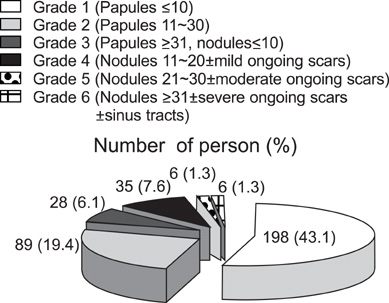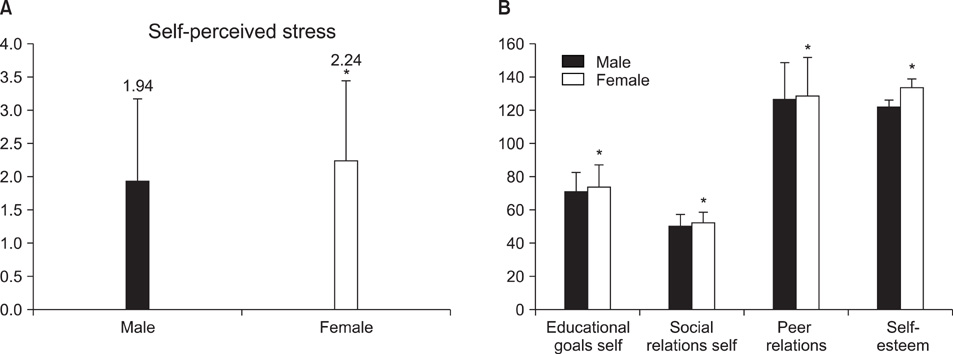Ann Dermatol.
2009 May;21(2):125-129. 10.5021/ad.2009.21.2.125.
Psychosocial Aspects of Acne Vulgaris: A Community-based Study with Korean Adolescents
- Affiliations
-
- 1Department of Dermatology, Ajou University School of Medicine, Suwon, Korea. esl@ajou.ac.kr
- 2Department of Psychiatry, Ajou University School of Medicine, Suwon, Korea.
- 3Department of Dermatology, Gachon Medical School, Incheon, Korea.
- KMID: 2219379
- DOI: http://doi.org/10.5021/ad.2009.21.2.125
Abstract
-
BACKGROUND: Acne vulgaris is a distressing condition that affects the majority of adolescents, but the impact of acne vulgaris on the psychological aspects in this age group is poorly understood.
OBJECTIVE
The purpose of this study was to determine the prevalence of acne, and the level of emotional, social, and functional impairments among Korean adolescents with acne.
METHODS
Five hundred four middle school students (13~16 years) participated. The severity of acne was graded by visual examination using the Korean Acne Grading System. Self-reported questionnaires, including subjective acne severity rating, the Self Image Questionnaire, the Rosenberg Self-Esteem Questionnaire, the Index of Peer Relations, and the Beck Depression Inventory were used to assess psychologic status.
RESULTS
There was a prevalence of acne in 78.9% of the study samples, with 10.2% of students having moderate-to-severe acne. Acne was more prevalent and severe in boys than girls. Participants with severe acne and girls had higher levels of emotional and social impairments. The longer the acne persisted, the more stress the students felt. The degree of stress and extent of self-image impairment were related to subjective severity more than objective grading.
CONCLUSION
Acne is a common disorder among Korean adolescents and appears to have a considerable impact on mental health. Dermatologists should be aware of the importance of basic psychosomatic treatment in conjunction with early medical, educational intervention in the management of acne.
Figure
Reference
-
1. White GM. Recent findings in the epidemiologic evidence, classification, and subtypes of acne vulgaris. J Am Acad Dermatol. 1998. 39:S34–S37.
Article2. Koo J. The psychosocial impact of acne: patients' perceptions. J Am Acad Dermatol. 1995. 32:S26–S30.
Article3. Fried RG, Wechsler A. Psychological problems in the acne patient. Dermatol Ther. 2006. 19:237–240.
Article4. Koo JY, Smith LL. Psychologic aspects of acne. Pediatr Dermatol. 1991. 8:185–188.
Article5. Thomas DR. Psychosocial effects of acne. J Cutan Med Surg. 2004. 8:Suppl 4. 3–5.
Article6. Smithard A, Glazebrook C, Williams HC. Acne prevalence, knowledge about acne and psychological morbidity in mid-adolescence: a community-based study. Br J Dermatol. 2001. 145:274–279.
Article7. Walker N, Lewis-Jones MS. Quality of life and acne in Scottish adolescent schoolchildren: use of the Children's Dermatology Life Quality Index (CDLQI) and the Cardiff Acne Disability Index (CADI). J Eur Acad Dermatol Venereol. 2006. 20:45–50.
Article8. Rubinow DR, Peck GL, Squillace KM, Gantt GG. Reduced anxiety and depression in cystic acne patients after successful treatment with oral isotretinoin. J Am Acad Dermatol. 1987. 17:25–32.
Article9. Sung KJ, Rho YS, Choi EH, Oh JJ, Lee JH, Kim S, et al. Korean acne grading system. Korean J Dermatol. 2004. 42:1241–1247.10. Song IS. The human mind and self-concept. 1989. 1st ed. Seoul: Yangseowon.11. Rosenberg M. Society and the adolescent self image. 1965. 1st ed. Princeton, NJ: Prinston University Press.12. Hudson WW. The clinical measurement package: a field manual. 1982. 1st ed. Chicago: Dorsey Press.13. Beck AT, Ward CH, Mendelson M, Mock J, Erbaugh J. An inventory for measuring depression. Arch Gen Psychiatry. 1961. 4:561–571.
Article14. Kilkenny M, Stathakis V, Hibbert ME, Patton G, Caust J, Bowes G. Acne in Victorian adolescents: associations with age, gender, puberty and psychiatric symptoms. J Paediatr Child Health. 1997. 33:430–433.
Article15. Freyre EA, Rebaza RM, Sami DA, Lozada CP. The prevalence of facial acne in Peruvian adolescents and its relation to their ethnicity. J Adolesc Health. 1998. 22:480–484.
Article16. Rademaker M, Garioch JJ, Simpson NB. Acne in schoolchildren: no longer a concern for dermatologists. BMJ. 1989. 298:1217–1219.
Article17. Pearl A, Arroll B, Lello J, Birchall NM. The impact of acne: a study of adolescents' attitudes, perception and knowledge. N Z Med J. 1998. 111:269–271.18. Purvis D, Robinson E, Merry S, Watson P. Acne, anxiety, depression and suicide in teenagers: a cross-sectional survey of New Zealand secondary school students. J Paediatr Child Health. 2006. 42:793–796.
Article19. Uslu G, Sendur N, Uslu M, Savk E, Karaman G, Eskin M. Acne: prevalence, perceptions and effects on psychological health among adolescents in Aydin, Turkey. J Eur Acad Dermatol Venereol. 2008. 22:462–469.
Article20. Kellett SC, Gawkrodger DJ. The psychological and emotional impact of acne and the effect of treatment with isotretinoin. Br J Dermatol. 1999. 140:273–282.
Article21. Krowchuk DP, Stancin T, Keskinen R, Walker R, Bass J, Anglin TM. The psychosocial effects of acne on adolescents. Pediatr Dermatol. 1991. 8:332–338.
Article22. Lee SH, Park TH, Kang WH, Whang KK, Lee CW, Sung KJ, et al. A statistical analysis of acne patients who visited university hospitals recently. Korean J Dermatol. 1996. 34:386–393.23. Kim HJ, Lim YS, Choi HY, Myung KB. A study on quality of life of patients with acne. Korean J Dermatol. 1998. 36:850–854.24. Kang MJ, Hahm JH. Comparative study of acne on clinical features and patient understandings in adolescence and post-adolescence. Korean J Dermatol. 2000. 38:589–599.25. Lee SH, Ahn BK. The quality of life of acne patients. Korean J Dermatol. 2003. 41:1271–1277.26. Lee SH, Cho HS, Seung NR, Jung SJ, Kim CW, Jo HJ, et al. Quality of life of acne patients. Korean J Dermatol. 2006. 44:688–695.



